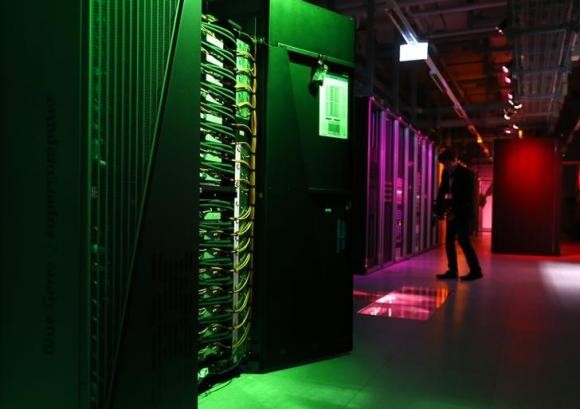U.S. Exascale Supercomputer will Obsolete China's Tianhe-2
| Marco Foronda | | Dec 06, 2014 08:04 AM EST |
(Photo : REUTERS/DENIS BALIBOUSE) The IBM Blue Gene Q Supercomputer .
American intelligence agencies announced Friday their plans to develop and build a new superconducting supercomputer that will increase the current computing capacity while simultaneously reducing energy consumption and the physical footprint of the machines.
The "Cryogenic Computer Complexity" program" or C3 is a multi-year research project of the Intelligence Advanced Research Projects Activity (IARPA), a branch of the U.S. intelligence community.
Like Us on Facebook
The aim of the C3 program is to build an exascale supercomputer capable of at least 1,000 petaflops or 1 exaflop. This massive speed is about 40 times faster than the world's existing supercomputers. This incredibly fast machine will be used by U.S. intelligence agencies like the CIA and NSA for decoding encrypted messages.
China's Tianhe-2 supercomputer, the world's fastest, has a speed of 33.9 petaflops.
The project has awarded contracts to three major technology companies: International Business Machines, Raytheon BBN Technologies and Northrop Grumman.
The C3 program aims to use recent breakthroughs in supercomputing technologies to build a superconducting supercomputer with "a simplified cooling infrastructure and a greatly reduced footprint."
The required power, space and cooling state for the current supercomputers is based on the complementary metal oxide semiconductor (CMOS) technology that's becoming uncontrollable.
"Computers based on superconducting logic integrated with new kinds of cryogenic memory will allow expansion of current computing facilities while staying within space and energy budgets, and may enable supercomputer development beyond the exascale," said Marc Manheimer, C3 program manager at IARPA.
The U.S. is driving its effort to create the next generation of superconducting supercomputers to compete with the world's fastest computer from Europe, Japan and China. China's 55 petaflop Milky Way is based on complementary metal oxide semiconductor technology that requires tens of megawatts to power.
The supercomputers are expected to be much smaller and will require less physical infrastructure to cool. Also, it's expected to have a much more reduced energy footprint than current machines.
TagsUS Intelligence Build Supercomputer, Supercomputer, superconducting supercomputer, Intelligence Advanced Research Projects Activity, Cryogenic Computer Complexity program, complementary metal oxide semiconductor, CMOS, C3 program, US intelligence
©2015 Chinatopix All rights reserved. Do not reproduce without permission
EDITOR'S PICKS
-

Did the Trump administration just announce plans for a trade war with ‘hostile’ China and Russia?
-

US Senate passes Taiwan travel bill slammed by China
-

As Yan Sihong’s family grieves, here are other Chinese students who went missing abroad. Some have never been found
-

Beijing blasts Western critics who ‘smear China’ with the term sharp power
-

China Envoy Seeks to Defuse Tensions With U.S. as a Trade War Brews
-

Singapore's Deputy PM Provides Bitcoin Vote of Confidence Amid China's Blanket Bans
-

China warns investors over risks in overseas virtual currency trading
-

Chinese government most trustworthy: survey
-

Kashima Antlers On Course For Back-To-Back Titles
MOST POPULAR
LATEST NEWS
Zhou Yongkang: China's Former Security Chief Sentenced to Life in Prison

China's former Chief of the Ministry of Public Security, Zhou Yongkang, has been given a life sentence after he was found guilty of abusing his office, bribery and deliberately ... Full Article
TRENDING STORY

China Pork Prices Expected to Stabilize As The Supplies Recover

Elephone P9000 Smartphone is now on Sale on Amazon India

There's a Big Chance Cliffhangers Won't Still Be Resolved When Grey's Anatomy Season 13 Returns

Supreme Court Ruled on Samsung vs Apple Dispute for Patent Infringement

Microsoft Surface Pro 5 Rumors and Release Date: What is the Latest?










